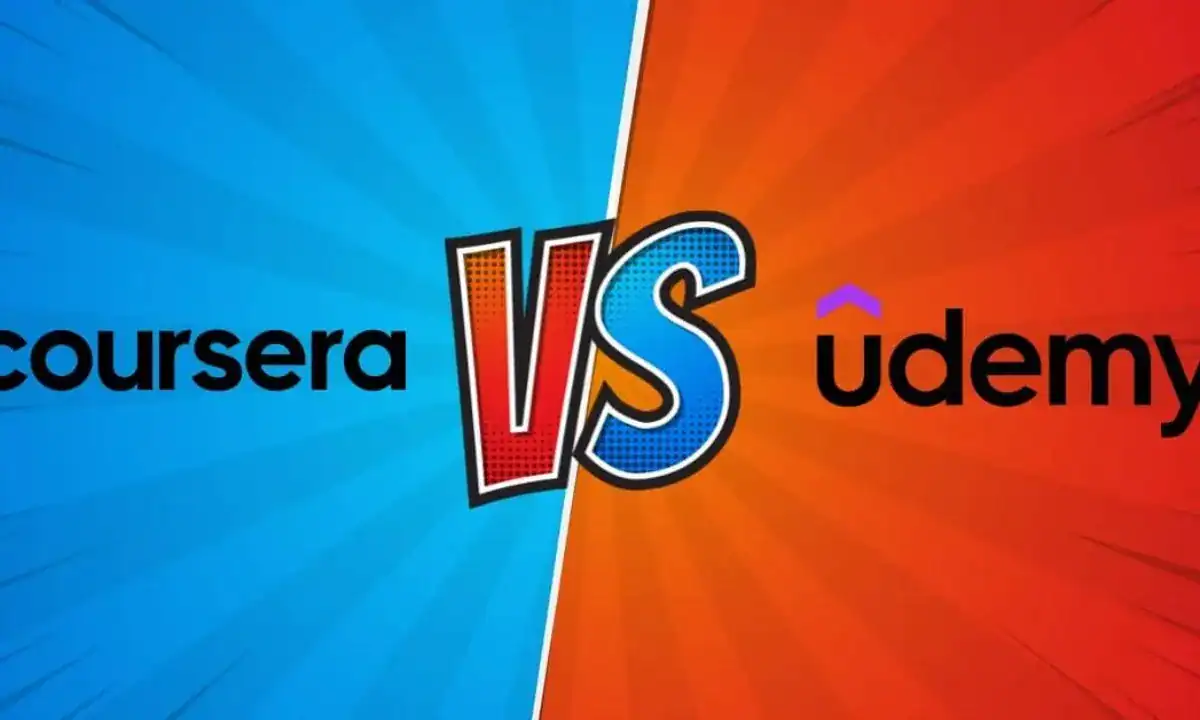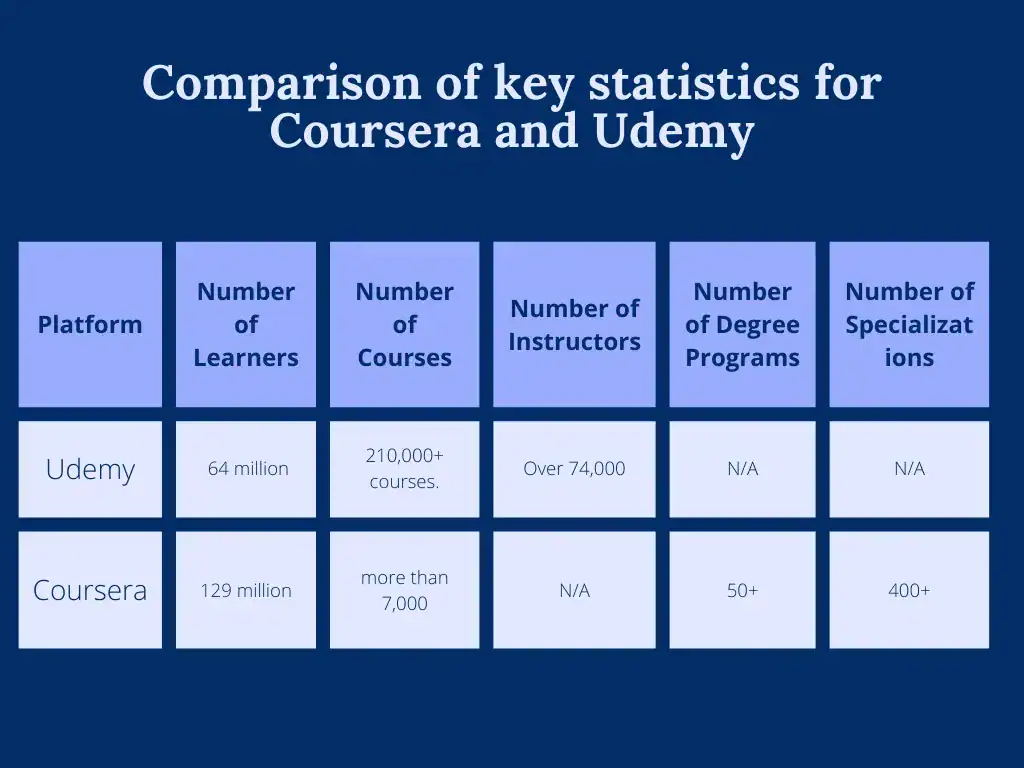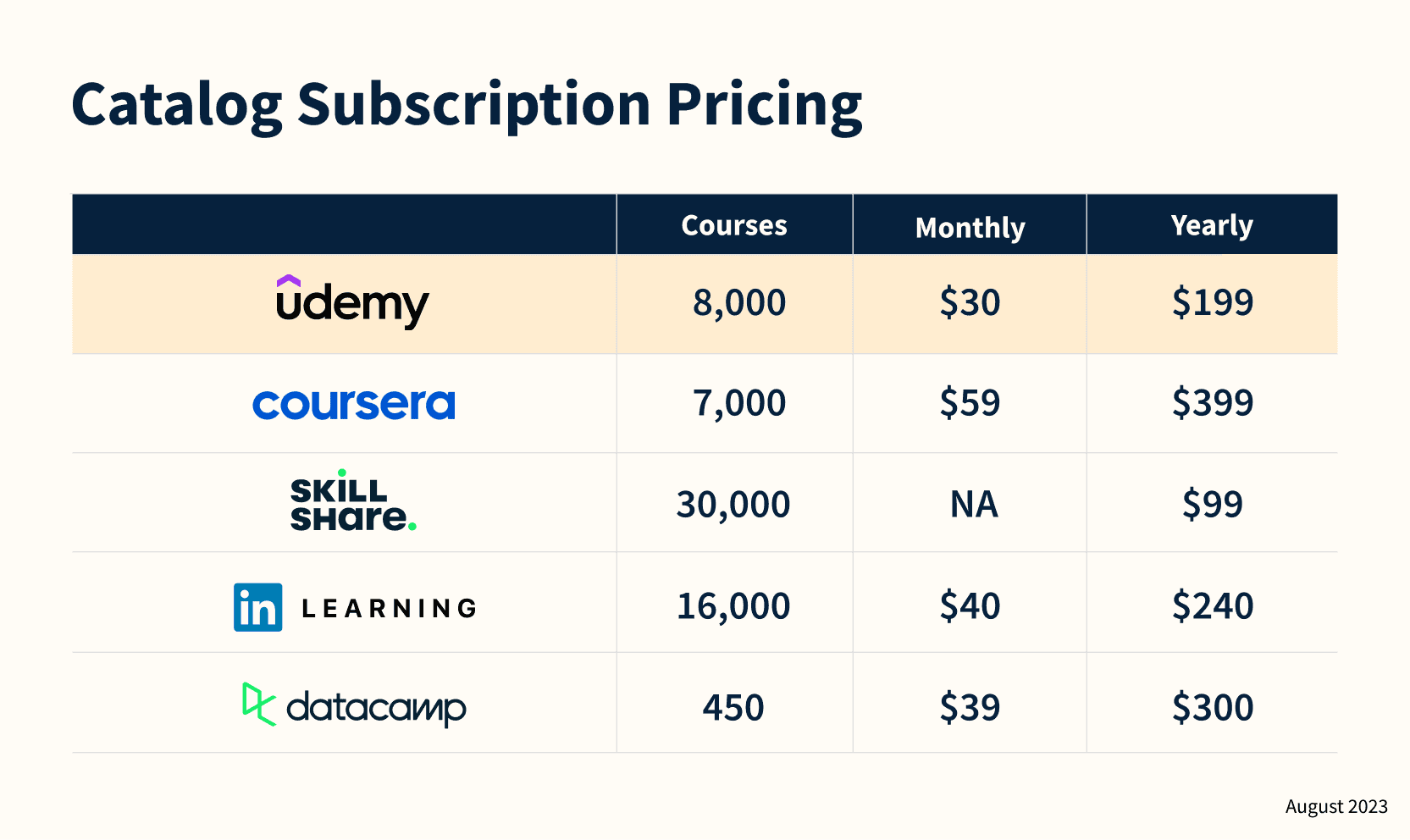Udemy and Coursera dominate today’s fast-growing e-learning world. The digital education market continues to expand and will reach $325 billion by 2026. These platforms lead the educational revolution with impressive numbers. Coursera has grown to over 129 million registered users, and Udemy’s course enrollments have reached 883 million.
Each platform takes a unique path to deliver valuable learning opportunities. Coursera teams up with universities and industries to deliver professional certifications and advanced degrees. Udemy works more like an open marketplace that features over 75,000 instructors teaching in about 75 languages. Students looking for structured academic programs or practical skills need to get a full picture of these platforms. This piece covers everything from course variety and learning experience to certification value and pricing models. You’ll discover which platform matches your educational goals in 2025.
Platform Overview: What Are Udemy and Coursera?

Image Source: Brian Vander Waal
Udemy and Coursera might look similar on the surface, but their business models create two completely different approaches to online learning that affect course creation and student experiences.
Udemy: Open Marketplace for Instructors
Udemy works as a global course marketplace that lets anyone with expertise create and sell courses. Since its launch in 2010, the platform has become one of the largest online learning communities worldwide. Students can now access more than 204,000 courses in 75 languages. This open approach lets instructors keep ownership of their content while reaching Udemy’s massive audience of over 740 million students in more than 180 countries.
The platform gives instructors a clear opportunity to share knowledge and make money through course sales. Creating and maintaining an instructor account costs nothing. Course sales give instructors 37% of revenue from Udemy-driven purchases, which increases to 97% when students buy through the instructor’s coupon or referral link. Udemy instructors earned a combined $161.40 million in 2020 alone.
Coursera: University and Industry Partnerships
Coursera takes a different path by building strategic collaborations with prestigious universities and leading companies. Stanford professors started Coursera in 2012, and it now partners with over 350 educational institutions like Stanford and Duke, plus major corporations such as Google, IBM, and Meta. This approach focuses on academic excellence and real-world relevance.
Quality control comes through institutional partnerships, unlike Udemy’s open instructor system. Coursera reaches over 162 million registered learners in more than 190 countries. The platform offers about 7,000 courses, specializations, and degree programs—substantially fewer than Udemy but with stronger academic backing.
Target Audience and Use Cases
Each platform attracts different types of learners based on their goals. Udemy serves people who want specific skills or practical knowledge without formal credentials. The “learn at your own pace” style works best for:
- Professionals who need to boost specific job-related skills
- Freelancers and entrepreneurs building practical abilities
- Hobbyists exploring personal interests or creative projects
Coursera appeals to learners who want structured education with recognized credentials. You’ll often find these people on Coursera:
- Students seeking university-backed education
- Professionals working toward industry-recognized certifications
- Career-changers needing complete skill development with credible verification
Udemy shines at teaching specific, practical skills flexibly, while Coursera delivers a structured, credential-focused experience supported by academic institutions and major corporations.
Course Variety and Structure

Image Source: Fox LMS
These two online course platforms show clear differences in their course offerings and program structures.
Course Types: Self-paced vs Structured Programs
Both platforms let you learn at your own pace, but they take different approaches. Udemy shines with its lifetime access policy – you buy a course once and can come back to it whenever you want. This works great for busy professionals who need extra time to finish their coursework.
Coursera takes a more organized approach. You can still learn at your own speed, but courses come with suggested deadlines and tougher academic standards. Students who need more time can join another monthly group to finish up. Even the degree programs, which are technically self-paced, need you to complete assignments and work with other students.
Subject Coverage: 200K+ Udemy vs 7K+ Coursera
The size difference between these platforms tells an interesting story:
- Udemy has over 200,000 courses in a variety of subjects like business, technology, arts, music, and personal development
- Coursera provides about 7,000 courses, specializations, and degree programs
Udemy’s huge library exists because anyone can create and share courses. This means quality can vary quite a bit. Coursera keeps its catalog smaller but more selective through strategic collaborations with top universities and companies like Google, IBM, and Microsoft.
Learning Paths: Specializations and Degrees on Coursera
Coursera really stands out with its organized educational paths. Students can choose from:
- Guided Projects (1-2 hours): Quick skill-building modules
- Standard Courses (4-12 hours): Focused knowledge acquisition
- Specializations (1-3 months): Connected courses that help you master specific topics
- Professional Certificates (1-6 months): Career-focused training
- MasterTrack Certificates (4-7 months): University credentials that count toward degrees
- Full Degrees (2-4 years): Complete bachelor’s or master’s programs
Each specialization ends with hands-on projects to show what you’ve learned. Students can also take courses that count toward future degrees. This step-by-step approach lets you move from simple skills to detailed qualifications at a comfortable pace.
Your choice between these platforms comes down to what matters more – Udemy’s big selection and complete flexibility or Coursera’s academic reputation and structured path to recognized credentials.
Learning Experience and Interactivity
These two online course platforms differ in user experience that goes way beyond their content and pricing.
Video Quality and Production Standards
The open marketplace model of Udemy results in uneven production quality. Anyone can create courses, so video standards range from simple smartphone recordings to professional studio productions. Though Udemy performs audio, video, and production quality validation before publishing, quality varies among courses.
University partnerships help Coursera maintain steady production values. Most courses showcase professional lectures recorded in university settings or corporate studios. This creates a standardized learning environment that mirrors traditional academic settings.
Instructor Engagement and Peer Interaction
Udemy’s paid courses feature instructor engagement through Q&A sections and direct messaging. The platform doesn’t mandate instructor communication with students. Some teachers actively answer questions, while others provide minimal support.
Students experience traditional college-style instructor interaction on Coursera. They can connect with instructors through chats and discussion forums, and get feedback on graded work. Coursera also promotes peer learning through discussion boards and peer-reviewed assignments. This community-based approach helps curb the isolation students often feel in online education.
Mobile App and Offline Access
Strong mobile apps from both platforms support offline learning. Students using Udemy’s app can download videos to watch offline on Android and iOS devices. The app gives access to video lectures, article lectures, video-PDF mashups, quizzes, and extra resources offline.
Coursera’s feature-rich mobile app lets students download and view lectures offline – perfect for learning during commutes or in areas with poor internet. Both platforms need internet connection now and then to verify licenses and update progress.
Quizzes, Assignments, and Projects
Assessment styles differ between these platforms. Udemy offers quizzes and practice tests on all platforms, but limits coding exercises and assignments to desktop. Video-based teaching remains the main focus, supported by additional activities.
Coursera focuses on ground application through graded assignments, peer-reviewed projects, and thorough assessments. Students can add projects from most Coursera courses to their professional portfolios. This shows employers concrete proof of their skills, which matters more than just completing a course.
Certification and Career Value
The most important difference between these online course platforms is their certification offerings and the value they provide to learners who complete their programs.
Certificate Types: Completion vs Accredited
These platforms have different approaches to certification. Coursera is accredited by several organizations, including the American Council on Education. Their verified certificates have academic recognition. They offer:
- Course Certificates for single course completion
- Specialization Certificates for series of related courses
- Professional Certificates for industry-specific training
- MasterTrack Certificates that can count toward Master’s degrees
- Full degree programs with accredited university degrees
Udemy takes a different approach. They provide simple completion certificates that show course participation. These certificates don’t have accreditation from formal educational institutions. Students can’t use them for college credit or continuing education units.
Recognition by Employers
Employers view these platforms differently. Career experts say Coursera’s certificates have more value in professional settings because prominent institutions issue them. Your resume looks more credible with a Coursera certificate compared to Udemy listings.
Research shows that 90% of people who begin online courses never finish them. Completing any course shows your dedication to professional growth. Certificates from prominent organizations like Google, Microsoft, or Stanford University carry more weight than those from unknown instructors on either platform.
LinkedIn Integration and Resume Value
Both platforms connect easily with LinkedIn. You can add your certificates to your profile’s “Licenses & Certifications” section after completing courses.
Experts suggest different ways to present these certificates on your resume:
- For Coursera: Highlight the university or company partnership and the certification’s accredited status
- For Udemy: Focus on specific skills you learned rather than the certificate itself
These certificates prove your education and skill acquisition. They can boost your salary by up to 20% when used effectively. The main difference is clear – Coursera certificates show you’ve met professional standards, while Udemy certificates demonstrate personal growth and participation.
Pricing Models and Accessibility

Image Source: Class Central
Price often makes the final difference when you’re picking an online course platform, even after looking at features and content quality. Udemy and Coursera have different pricing setups that match their business goals and target students.
Udemy: One-Time Purchase Model
Udemy lets you buy courses one at a time. Course prices range from $19.99 to $199.99, but most cost between $19.00 and $59.00. You’ll get lifetime access to your courses after buying them. The platform runs sales often, and you can grab pricier courses for just $10.99-$15.99.
If you take lots of courses, Udemy’s Personal Plan costs $16.58 monthly. This gives you access to more than 12,000 selected courses in tech, business, and personal growth.
Coursera: Subscription and Free Audit Options
Coursera takes a different approach with mixed pricing. Single courses cost $29.00 to $99.00. Their special programs come at different price points:
- Guided Projects: $9.99 and up
- Specializations: $39.99-$49.00 monthly
- Professional Certificates: $49.00 monthly and up
- MasterTrack Certificates: $2,000 and up
- Full Degrees: $9,000 and up
Coursera Plus lets you access 90% of their content for $59.00 monthly or $399.00 yearly.
Financial Aid and Free Courses
These platforms handle accessibility quite differently. Coursera has an “audit” option that lets you see most course content free. They also help students who need financial support through an application process.
Both platforms have free courses, but Coursera leads by a wide margin. They offer about 7,600 free courses while Udemy has 600.
Best Free Online Course Builder Options
Teachers looking to create their own courses have other choices too. Thinkific lets you build and host courses free without charging transaction fees. GetResponse and Teachable also come with free plans that include AI tools to help create courses.
The right choice between online course platforms comes down to your learning goals after you learn about what each has to offer. These platforms excel in different ways based on what you want to learn.
Udemy excels for:
- Skill-specific, practical learning with immediate application
- Budget-conscious learners seeking affordable one-time purchases
- Professionals needing niche technical or creative skills
- Self-motivated learners who prefer completely flexible pacing
- Those who value course variety over institutional backing
Coursera stands out for:
- Academic credentials with recognized institutional backing
- Structured learning paths building toward career advancement
- Job-seekers requiring certificates that impress employers
- Students wanting interactive community and instructor participation
- Learners who prioritize quality over quantity of options
Your career stage and goals play a big role in the decision. Early-career professionals often get more value from Coursera’s structured approach since formal credentials help build credibility. Mid-career specialists might find Udemy’s targeted skill development more useful to fill specific knowledge gaps without extra academic work.
Your learning style matters too. Visual learners who pick up information quickly might love Udemy’s straightforward video lectures. People who learn better through discussion and feedback usually find Coursera’s interactive elements work better for them.
Time commitment makes a difference. Udemy courses take about 3-20 hours to finish, which works great for busy professionals. Coursera programs need more time—specializations usually take 3-6 months of steady work.
Motivation patterns should shape your choice. Udemy’s self-directed model works well if you thrive on independence. Coursera’s cohort-based approach gives you helpful structure if you do better with deadlines and accountability.
Both platforms serve different educational purposes with their own strengths. The best choice depends on how well the platform’s offerings match your learning goals, career plans, and what works best for you.
Comparison Table
| Feature | Udemy | Coursera |
|---|---|---|
| Platform Model | Open marketplace | Strategic collaborations with universities/industry |
| Number of Courses | 200,000+ | 7,000+ |
| Number of Users | 740M+ students | 162M+ registered learners |
| Languages Available | 75 languages | Not mentioned |
| Course Types | Individual courses | Guided Projects, Courses, Specializations, Professional Certificates, MasterTrack, Degrees |
| Instructor Model | Open to all creators | University professors & industry experts |
| Course Pricing | $19.99-$199.99 per course | $29-$99 per course |
| Subscription Option | Personal Plan: $16.58/month | Coursera Plus: $59/month or $399/year |
| Degree Programs | None | Full bachelor’s & master’s programs |
| Certificate Value | Non-accredited completion certificates | Accredited, university-backed certificates |
| Free Content | ~600 free courses | ~7,600 free courses |
| Financial Aid | Not mentioned | Available through application |
| Course Access | Lifetime access | Time-limited/Cohort-based |
| Learning Style | Self-paced, flexible | Structured with deadlines |
| Quality Control | Variable quality, simple validation | Strict quality standards |
| Offline Access | Yes, via mobile app | Yes, via mobile app |
| Target Audience | Skill-seekers, hobbyists, professionals | Degree-seekers, career-changers, academic learners |
Key Takeaways
Choosing between Udemy and Coursera depends on your learning goals, career stage, and preferred structure. Here are the essential insights to guide your decision:
• Udemy offers quantity and flexibility – With 200,000+ courses and lifetime access for $19-199 per course, it’s ideal for skill-specific learning and budget-conscious professionals seeking practical knowledge.
• Coursera provides quality and credentials – Partnering with 350+ universities and companies, it offers accredited certificates and degree programs that carry more weight with employers and academic institutions.
• Learning styles determine the best fit – Self-motivated learners who prefer complete autonomy thrive on Udemy, while those needing structure, deadlines, and peer interaction benefit from Coursera’s academic approach.
• Career impact varies significantly – Coursera certificates are generally more valued by employers due to institutional backing, while Udemy focuses on demonstrating specific skills rather than formal credentials.
• Free options favor Coursera – With 7,600 free courses versus Udemy’s 600, plus financial aid availability, Coursera offers better accessibility for budget-constrained learners.
The key is aligning the platform’s strengths with your specific needs: choose Udemy for immediate skill acquisition and maximum flexibility, or Coursera for structured learning paths and recognized credentials that advance your career.
FAQs
Q1. What are the main differences between Udemy and Coursera?
Udemy is an open marketplace with over 200,000 courses where anyone can teach, while Coursera partners with universities and companies to offer about 7,000 curated courses, specializations, and degree programs. Udemy focuses on practical skills with flexible pacing, while Coursera provides more structured, credential-focused learning experiences.
Q2. How do the pricing models differ between the two platforms?
Udemy primarily uses a one-time purchase model, with courses typically ranging from $19.99 to $199.99. Coursera offers various pricing options, including individual course purchases ($29-$99), specializations ($39.99-$49 monthly), and a Coursera Plus subscription ($59 monthly or $399 annually) for access to most of their content.
Q3. Which platform offers better career value and recognition?
Coursera generally provides better career value due to its accredited certificates and partnerships with recognized institutions. Employers often view Coursera certificates more favorably because they’re standardized and issued by established universities or companies. Udemy certificates, while valuable for skill demonstration, are not accredited and carry less weight in formal settings.
Q4. Are there free learning options available on both platforms?
Yes, both platforms offer free courses. Coursera provides significantly more free content with approximately 7,600 free courses, compared to Udemy’s 600. Additionally, Coursera offers a unique “audit” option allowing learners to access most course content without paying, as well as financial aid for those who demonstrate need.
Q5. How do the learning experiences compare between Udemy and Coursera?
Udemy offers a more flexible, self-paced learning experience with lifetime access to purchased courses. Coursera provides a more structured approach with suggested deadlines, peer interaction, and instructor engagement. Coursera also emphasizes practical application through graded assignments and peer-reviewed projects, while Udemy focuses primarily on video-based instruction with supplementary quizzes and tests.

